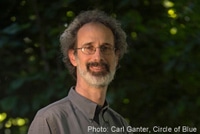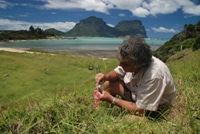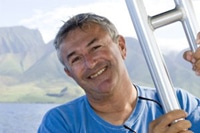Exerpted from the 2004 Stroud Center Annual Report
The Deepness and The Dead Zones
The second annual Water’s Edge lecture on October 8, 2004 was a celebration, a connection and a lament. Sylvia Earle, marine biologist, National Geographic Society’s Explorer-in-Residence and world-record diver fondly dubbed “Her Deepness,” gave the 275 in attendance a glimpse into the magical underwater world which she has done so much to explore, understand and protect.
What is the Connection Between Salt Water and Fresh Water?
Streams and rivers owe their existence to the oceans,” said Dr. Sweeney in his
introduction, describing the cycle of evaporation and precipitation that
recharges our fresh water. But both he and Earle emphasized that oceans also depend on the streams and rivers, and they noted that the decreasing numbers that flow regularly to the sea and the increasing amounts of pollutants they carry have caused dead zones — places where there is no oxygen — to double around the world since 1990. We cannot address the fate of the oceans without addressing the conditions of our rivers and their watersheds.
Dr. Earle celebrated the oceans both as the source of all life on Earth and as places that teem with living things we rarely see and barely understand. “Every night the greatest migration on Earth takes place . . . to the surface of the oceans,” she said, while behind her sparkled filmed images of an incredible — and deadly — nocturnal oceanic ballet. “One thing consumes another, and life goes on.” Oceans, she said, make our human lives possible. Not only are their waters “the great thermo-regulator of the planet,” but they are “the lifeblood that sustains us.”
Yet Dr. Earle’s celebration was also a lament.
“What once seemed an infinite realm, is, in fact, a fragile resource. We have taken our oceans and their bounty for granted,” said Earle. “…and now we must awaken to the reality that we have polluted their waters and devastated their ecosystems.”
In the last 50 years, the populations of big fish have declined by 90 percent, as humans have relentlessly strip-mined the oceans. “It is okay to go out and catch dinner,” said Earle. “It is not okay to catch dinner with a bulldozer, which is what trawls do. We are abusing the waters of the world.”
As the catches get smaller, as warnings about eating fish grow louder and as the “dead zones” induced by manmade pollution expand, said Earle, “we are learning the hard way that the ocean is finite, too.” Yet, she said, we are doing little to protect it – noting that, while we have preserved 12 percent of the terrestrial ecosystem, we have preserved a fraction of one percent of our oceans.
One reason for that is because we know so little about the oceans. While space
exploration captured the imaginations of millions — and the budgets of their governments — beginning in the late 1950s, 95 percent of the seas remain unexplored, said Earle, who has certainly done her part to change that by spending more than 7,000 hours under water and setting the depth record for solo diving. Still, she noted, only one person has ever been to the deepest part of the ocean — seven miles below the surface — and that happened more than 40 years ago.
Knowledge, she said, leads to caring, and she urged the support of underwater
exploration, “in the spirit of Lewis and Clark,” as a way of learning about and protecting the oceans. “There is as big an America underwater as there is above.” The future, concluded Earle, requires us to think of the world in two ways. First, see it as an astronaut sees it: “It is all one system and all of us are dependent on its integrity.” And then, think of it “from the perspective of those not yet born.”



